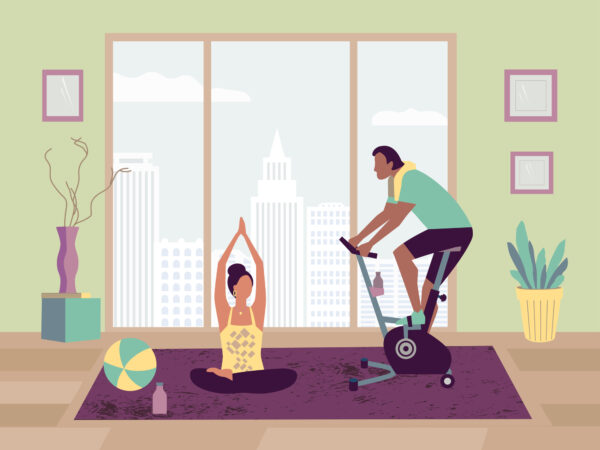
Numerous studies have shown that Botox is not taken into blood circulation or transported by injected muscles.
Many people considering getting Botox are concerned about returning to their normal workout program. Will getting some exercise change anything? What potential hazards might arise? In this piece, we’ll dispel some myths and give you some pointers on getting back into shape after getting Botox.
Myth #1: Dislocation will occur if you exercise too soon after getting Botox
The belief that exercising after Botox will cause your muscles to “pop” is a common urban legend. It is a common fear that Botox will spread from the injection site if you work out soon after receiving the injections, which could have unintended consequences. Nevertheless, this claim is not backed by any scientific data. Numerous studies have proven that Botox is neither absorbed into the bloodstream nor carried to other areas of the body by the muscles into which it was injected.
Myth #2: Exercise will hasten the fading of Botox
It’s also widely believed that physical activity will hasten the breakdown of Botox, diminishing the effects more quickly. Yet this is simply not so. The effectiveness of Botox depends upon variables such as the dose used, the individual’s metabolism, and the level of muscle activity in the treated area. Your exercise routine does not directly affect the length of your Botox treatment.
Tips for Working Out After Botox
If you have recently had Botox, you should know that there are specific guidelines you should follow before getting back into exercise. Consider the following suggestions:
- Allow your body to readjust and the Botox to take effect in the muscles it was injected into for at least 24 hours before you try anything else. You should give yourself at least 24 hours before starting any kind of rigorous physical activity.
- Do not expose yourself to too much heat, as this could compromise Botox’s ability to relax your muscles by increasing your blood flow. After receiving this treatment, you should wait at least 24 hours before engaging in any hot yoga, sauna, or steam room sessions.
- Pay attention to your facial expressions and try not to make too many if you have recently had Botox injections in areas like your forehead or around your eyes. Overactive movements in the treated area may affect the results. Keep your expression blank or at least relaxed while you work out.
- Remember to drink plenty of water; this will help your body in general and will also improve the effectiveness of your Botox. Take in plenty of fluids before, during, and after your workout to keep yourself properly hydrated. This may aid in promoting normal blood flow and speeding up the healing process.
- Watch out for activities that might cause the treated area to be subjected to too much pressure or friction. If you have had Botox injections in your forehead, for instance, you should not put anything tight around your head, like a headband, or a hat, on your head for a while.
- Inquire with your medical professional or the person who performed the Botox treatment about any specific aftercare instructions you may need to follow. They will tailor their recommendations to your specific requirements and the areas being addressed.
Keep in mind that everyone reacts differently to Botox, so it’s essential that you pay heed to your body if you experience any strange or worrying side effects. During or after exercise, you should cease activity and seek medical attention if you have any symptoms of chronic pain, severe swelling, or other unfavorable reactions.
Research on Exercise Following Botox

Exercise has no impact on the effectiveness or dispersion of Botox injections.
Few studies have looked at the effects of activity after botox injections, although many have looked at its mobility and distribution in the body. The results of these investigations consistently show that Botox stays put in the muscles where it was injected and does not spread to other places, even when subjects engage in vigorous physical activity.
According to research published in the Journal of Cosmetic Dermatology, Botox injections do not travel outside of the intended muscles when people work out. The workout did not affect the distribution or efficacy of Botox injections, according to another study published in Plastic & Reconstructive Surgery.
These findings, together with clinical experience, lend credence to the idea that physical activity does not significantly increase the risk of Botox treatments or diminish their efficacy. Keep in mind that everyone reacts differently to Botox, so it’s best to stick to the instructions given to you by your medical practitioner.
Pay attention to your physical cues and take expert advice
While it is normally safe to exercise after receiving Botox, it is important to pay attention to your body and stop if you feel any pain or discomfort. Exercise should be stopped and medical help sought if any discomfort, swelling, or other worrying signs develop during or thereafter.
Furthermore, there may be individual differences in regard to care, health background, and other factors. Thus, it is crucial to speak with your medical professional or the person who gave you the Botox. They will be able to provide you with specific advice based on your situation and answer any questions you may have.
Dentox makes it easier for medical and aesthetic experts to learn how to administer Botox injections safely and effectively. You can attend a seminar in one of our many locations all over the nation, or you can take one of our courses live, online, or on demand. Please visit https://dentox.com/live-courses/ and https://dentox.com/all-courses/botox-training/ to discover more about our in-person and virtual courses.







